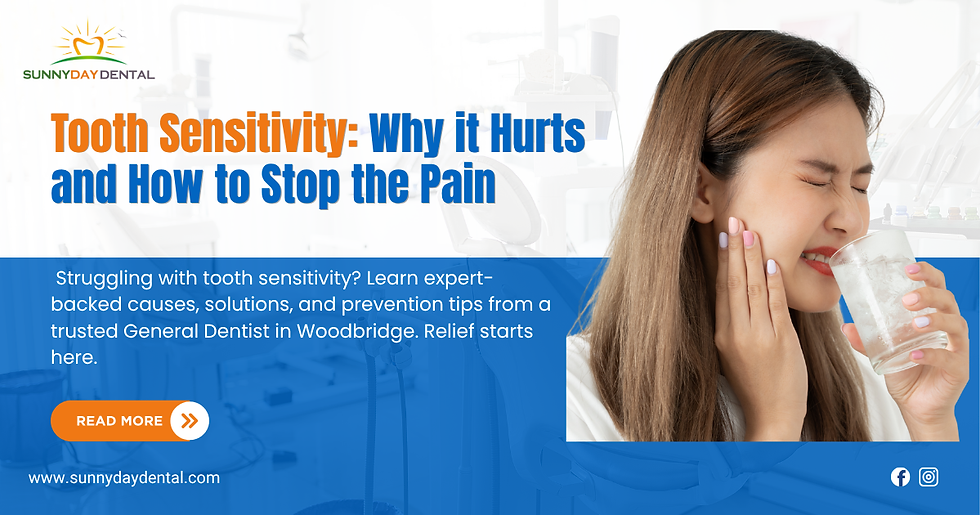Malocclusion: 3 Common Types & How to Fix Them Fast
- Sunny Day Dental
- Apr 28
- 3 min read

Malocclusion, in simple terms, refers to a misalignment of teeth or an incorrect relationship between the teeth of the two dental arches when they approach each other as the jaws close. While a perfect bite is rare, significant misalignment can impact oral health, chewing, speech, and even self-confidence. Fortunately, expert care from a reputable dental office in Woodbridge can help diagnose and treat malocclusion effectively, restoring both function and aesthetics.
According to the American Association of Orthodontists (2025), nearly 60% of people worldwide experience some form of malocclusion during their lifetime, making early diagnosis and correction crucial.
3 Common Malocclusion Types and How to Fix Them Fast
Understanding malocclusion types is the first step toward achieving a healthier, more confident smile. With guidance from a trusted dental office in Woodbridge, you can explore the most frequent kinds and their fastest treatment options. Let’s dive in:
1. Overbite (Deep Bite)
What It Is: An overbite occurs when the upper front teeth excessively overlap the lower front teeth. Mild overbites are common, but a pronounced overbite can lead to jaw pain, tooth wear, and gum problems.
Fast Fix:
Invisalign clear aligners (new-generation options in 2025 are quicker and more discreet)
Traditional braces for more severe cases
Orthodontic retainers to maintain correction
Early intervention from a trusted orthodontics in Woodbridge can drastically cut down treatment time!
2. Underbite
What It Is: An underbite happens when the lower teeth protrude beyond the upper teeth. It can affect chewing, speaking, and even facial aesthetics.
Fast Fix:
Surgical orthodontics (for severe cases, often combined with braces)
Clear aligners for moderate underbites
Expanders or headgear for children to avoid future complications
Correcting this type of malocclusion early can prevent the need for invasive surgery later.
3. Crossbite
What It Is: A crossbite occurs when some of the upper teeth sit inside the lower teeth when biting down. It can involve the front teeth (anterior crossbite) or the back teeth (posterior crossbite).
Fast Fix:
Palatal expanders (especially effective in younger patients)
Invisalign and braces for adults
Orthognathic surgery in extreme adult cases
A misaligned bite like a crossbite can cause uneven jaw growth if left untreated.
What are the 3 Common Types of Malocclusion?
The three most common malocclusion types are overbite, underbite, and crossbite. Fast fixes include Invisalign, traditional braces, palatal expanders, and in severe cases, surgical correction. Early orthodontic consultation can make treatment quicker and more effective.
Why Early Diagnosis Matters?
Malocclusion types can worsen over time if not addressed. Children and teenagers can benefit immensely from early orthodontic screenings. Even adults can achieve excellent results, especially with the advanced technologies like 3D imaging and custom aligners now available at a leading dental office in Woodbridge in 2025.
Signs you might need a consultation:
Difficulty biting or chewing
Speech problems
Frequent jaw pain or headaches
Visibly crooked or crowded teeth
The earlier you intervene, the simpler and quicker the treatment!
How an Orthodontics in Woodbridge Can Help?
An experienced orthodontics in Woodbridge will:
Perform a thorough assessment (including 3D scans and X-rays)
Recommend the best personalized treatment (aligners, braces, retainers)
Monitor your progress closely for optimal, quick results
Modern techniques mean you no longer have to live with a misaligned bite or hide your smile!
Transform Your Smile Fast with Sunny Day Dental
If you're noticing signs of malocclusion or want a straighter, healthier smile, Sunny Day Dental is here to help. As your trusted orthodontics in Woodbridge, we use the latest orthodontic technologies to provide fast, effective, and comfortable treatments tailored to your needs.
FAQs
Q1. Can malocclusion correct itself over time?
In mild cases among children, slight improvements may occur as the jaw develops. However, most moderate to severe malocclusion cases require professional treatment to correct fully.
Q2. Is Invisalign effective for all malocclusion types?
Invisalign is highly effective for mild to moderate overbites, underbites, and crossbites. Severe cases might need a combination of Invisalign and other orthodontic solutions.
Q3. How long does it typically take to fix a misaligned bite?
Treatment times vary depending on severity, but with today's advanced methods, minor cases can be corrected within 6-12 months. Severe malocclusions may take 18-24 months.
Q4. Are there any risks in leaving malocclusion untreated?
Yes! Untreated malocclusion can lead to gum disease, jaw pain, excessive tooth wear, difficulty chewing, and even digestive problems due to improper chewing.
Q5. What age is best to start treatment for malocclusion?
The ideal age is between 7 and 14 years, while the jaw is still growing. However, adults can achieve excellent outcomes too with the help of customized orthodontic solutions available today.




Comments